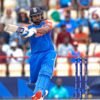Cricket
World Cup season: Rugby lessons for cricket but DRS better than TMO | Cricket
[ad_1]
While the cricket grabbed your attention over the weekend, another World Cup drew to a close, after seven weeks. Defending champions South Africa became the first country to win four rugby World Cups, the first also no doubt to squeeze through three rounds of knockouts separated from its opposition by only a single point each. In Saturday night’s final, they beat New Zealand 12-11. New Zealand could have complained that they were hard done by the rules regarding Television Match Official (TMO), except of course the Kiwis don’t whinge.

Wait, a World Cup final snatched away from New Zealand due to a stupid rule? Isn’t that what … Yes, yes, we remember boundary countback. Right now, the rugby world and governing body World Rugby are in a right royal shemozzle about the rule (details below), but much else ties the cricket and rugby World Cups together. Since 1999, both sports have shared the same odd-numbered year to host their biggest tournament. They overlapped for the first time this year because India chose to host the Cup at the start of its season as towards the end would have meant a clash with IPL.
The 2023 Rugby World Cup (RWC) began in France a month before cricket’s and it ended at the halfway point of CWC2023. Comparisons are inevitable but here’s a similarity: the cricket World Cup, like rugby, will stage 48 matches before finding the champion. Both sports are played across more than one format (white- and red-ball cricket, rugby union and rugby sevens) and have been dominated by a tight group of older member nations, accused of a “closed shop” mentality by younger aspirants.
There the similarities end. There are ten teams participating in CWC2023, with 14 promised in 2027. The CWC is the third largest nation-versus-nation media rights property in sport after the Olympics and the FIFA World Cup. ICC’s latest four-year (2024-2027) bundle of media rights is said to be worth around $ 2 billion. Rugby’s media rights are miniscule, never formally announced, but will not be higher than the $ 250-300m range. The size and appetite of the Indian market in cricket is what drives the big difference in media rights value.
But unlike cricket, rugby’s World Cup appears more expansive and inclusive. Since going professional in 1999, RWC has aways had 20 teams, up from 16 in its first three editions. Of the 34 teams that were initially in contention for France2023, 12 were automatic qualifiers from their finish in their respective pools in RWC2019. The eight remaining spots made it through regional and play-off competitions. RWC2027 will feature 24 teams with six groups of four teams each, the competition lasting six, not seven weeks. For the first time, it will feature an extra pre-quarterfinal knock-out round.
There is also a move to re-align rugby’s international calendar with the creation of a two-tier Nation’s League, which starts in 2026 featuring two 12-team divisions. The top division will have the strongmen from the northern hemisphere (England, Scotland, Ireland, Wales, France, Italy) and southern hemisphere (New Zealand, Australia, South Africa, Argentina) plus Japan and Fiji.
The second division, also featuring 12 teams, will be run by World Rugby with promotion and relegation starting in 2030. World Rugby chairman Sir Bill Beaumont said 2026 will mark a new era for the sport that “will support the many and not the few… beyond its traditional and often self-imposed boundaries.”
Both sports were part of the 1900 Paris Olympics, rugby union played for three more editions (1908, 1920 and 1924) before returning in Rio2016 with its highly popular Sevens format. Cricket’s taken longer, 12 years after Sevens its T20 format making its entry in Los Angeles 2028 with six teams. (Rugby sevens had 14). World Rugby has 114 full-member unions and 18 associated unions. The ICC has 12 full members and 94 Associate members.
Yes, we know cricket operates with a very different set of dynamics and conditions, on and off the field. But it has more money and resources. Why then is it hard to shake that feeling that if given cricket’s numbers – either financial or fan base – World Rugby would make a better fist of it than ICC?
When compared to a sport bursting with positivity and forward thinking, cricket is repeatedly left resembling a middle-aged grump. But getting back to the RWC final TMO shemozzle, it was cricket that finally scored a point against the cooler kids. Cricket’s Decision Review System (DRS) came through looking less clunky and more efficient than rugby’s TMO interventions. The pace of play in cricket allows participants to question official calls. These days rugby referees are finding their decisions re-assessed and overturned by external TMO notice. Somewhat like the fourth umpire being able to ask for a referral over the on-field umpire’s earpiece.
In Saturday’s final, the frequent interruptions in play from TMO – often over infringements, and then contrarian calls on yellow cards against the two captains (All Blacks skipper Sam Cane’s 29th minute yellow card was upgraded to red while Siya Kolisi’s yellow for what looked like a similar foul wasn’t – were heavily criticised. For breaking the play, undermining the referee and playing (electronic) god. Nigel Owens, a celebrated former international referee, said rugby has become “far too technical” due to the TMO involvement and that he wouldn’t have liked to officiate in this environment. “For me, get what matters, get the big decisions that everyone expects you go get, and if his toe is offside, who cares?”
He wrote elsewhere, “perfect has become the enemy of good because (they) are striving for a standard that is unachievable.” And this from a sport whose TV referral is strictly WYSIWYG (what you see is what you get) and does not involve a predictive path.
Another lesson from rugby to cricket: umpire’s call is umpire’s call. Live with it.
[ad_2]


















